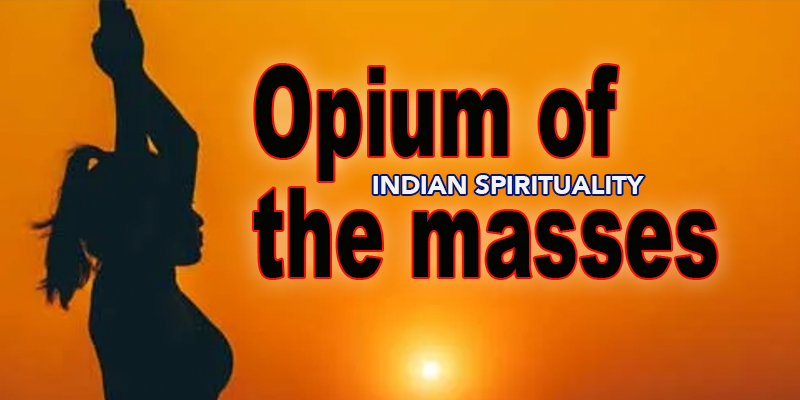
By Gurnam Singh | Opinion |
India has long been painted, by both its cultural elite and Western admirers, as a land of saints, sages and seekers. The prevailing stereotype is that of a chaotic yet spiritually rich society, home to ancient wisdom and divine revelation passed down through generations of spiritual teacher’s or Gurus (a class of people who lead us from ‘darkness’ (gu) to ‘light’ (ru). In a society that, until relatively recent times, was predominantly illiterate, such spiritual mythmaking gained immense authority and traction over millennia. What emerges is not a celebration of critical spirituality, although that is there, but an architecture of seduction, control, exploitation and abuse. This becomes so pervasive that those enthralled and entrapped by the promises of these Godmen, become its defenders and advocates.
The image of a nation that had preserved ancient wisdoms that can set a person free through various religions rituals and practices, is more fantasy than fact; it is a carefully curated mirage that conceals darker, more troubling realities. What is often marketed as a spiritual sanctuary is, in many cases, a space for manipulation, exploitation, and abuse. Rather than offering liberation, Indian spirituality frequently functions as a form of social sedation, an opium of the masses, to borrow Karl Marx’s poignant phrase.
The West’s enchantment with India is deeply implicated in perpetuating this myth. Since colonial times, Westerners have projected their fantasies onto the ‘East’, romanticising it as the spiritual counterpoint to their own rational, industrialised, materialistic societies. The colonial orientalist imagination turned India into a metaphysical playground where temples, ashrams and yogic retreats promised self-realisation and transcendence. From the Beatles’ pilgrimage to Rishikesh in the 1970’s to the latest yoga influencer retreat in Goa, India has been consumed as a place to ‘find oneself’. As Edward Said noted in Orientalism, “The Orient was almost a European invention… a place of romance, exotic beings, haunting memories and landscapes, remarkable experiences.”
Yet, peel back the glossy brochures and Kiplingesque narratives, and one finds a deeply commodified and corrupted spiritual economy. According to a piece published in the Daily Pioneer, based on a National Sample Survey Office report, in 2022, the temple economy alone is worth over US$40 billion or 2.32% of GDP in that year. They go onto suggest, it may be larger if one were to include secondary industries, ‘everything from flowers, oil, lamps, perfumes, bangles, sindur, images and puja dresses’, industries that are sustained largely by informal unprotected labour, especially women form so called scheduled castes. In this regard, one can argue, those who head the religious orders and temples are not simply spiritual teachers but often buisness men and traders offering ‘enlightenment’ in exchange for blind faith, financial offerings, and, too often, sexual submission. The litany of exposed “Godmen”preaching renunciation while living in grotesque luxury should provoke outrage. And yet, silence prevails. Why?
A friend of mine from California, a state famously peppered with Indian spiritual enclaves, recently shared a chilling case concerning Swami Satchidananda, dubbed the “Woodstock Guru”, who from the 1970’s to his death in 2002 at the age of 87, was revered for his message of peace, spirituality and simplicity. His sprawling 750-acre Yogaville Ashram in the mountains of Virginian USA still attracts those seeking tranquillity. But in 2022, his former assistant, Shanti Norris, inspired through the #MeToo movement, revealed a decade-long exploitative sexual relationship and systemic abuse at the heart of the community. As she noted, he “mimicked the life of a celibate monk while living differently.”
SEE ALSO: Sexual abuse in Sikh Spaces: time to lift the lid!
Such revelations are not exceptions; India has produced a disturbingly long list of spiritual leaders accused and occasionally convicted of crimes ranging from rape to murder. These, I suggest, are not isolated acts of deviance, but symptoms of a broader malaise. Indian spiritual institutions function much like gambling casinos: dazzling spaces promising transcendence, yet trapping vulnerable individuals in cycles of dependency, guilt, and silence. While some escape, many remain ensnared, their pain compounded by societal shame and the ever-present threat of retribution.
SEXUAL ABUSE,MORE STORIES HERE
Though it is convenient for mainstream organisations to argue that such behaviour is confined to cults, who by definition are not part of the mainstream, in truth, as I have periodically argued in my column in Asia Samachar, the problem cuts across regions and religions. From Sants and Babas to Pirs and Brahamgianis, the abuse of spiritual authority for personal gain appears rampant. What unites these figures is not theology but strategy: the exploitation of the sacred to legitimise the profane.
TO QUESTION IS HERESY
To fully comprehend this phenomena, it is critical to consider the wider social context. India remains a deeply patriarchal and religiously saturated country. In such a climate, to question spiritual authority is tantamount to heresy and accusations of blasphemy, which is often one of the first defenced deployed by the alleged abusers. Victims, especially women (and children), who, because of patriarchy and misogyny are already silenced withing the home and community, face almost impossible barriers to speaking out. However, as Arundhati Roy in her book Public Power in the Age of Empire (2004) observed, “There’s really no such thing as the ‘voiceless’. There are only the deliberately silenced, or the preferably unheard.” This culture of enforced silence is reinforced by religious institutions, state actors, the media, and even families, all complicit in maintaining the illusion of a spiritually exalted nation.”
Yet, amidst this hegemony, victims and survivors do somehow manage to ‘speak out’ reminding us that whatever there is oppression, there are seeds of resistance. In this regard, Italian Marxist philosopher Antonio Gramsci’s concept of cultural hegemony offers a potent framework for understanding dominance and resistance. Gramsci argued that power is maintained not merely through coercion but through the consent of the governed via the domination of values, beliefs and norms. Religious institutions, media, and education become tools through which the worldview of the powerful is normalised.
In India, this logic manifests through the persistence of coloniality and patriarchy, reflecting the continued domination of colonial and pre-colonial ideas and hierarchies even after formal independence. The ‘Godman’ phenomenon is not an aberration cultivated by colonisers, but a relatively permanent hegemonic fixture. Co-opted and rewarded by both colonial rulers in the past, and now by the Hindutva-driven BJP regime, these figures legitimise themselves through a script of cultural nationalism, mysticism, patriarchal values and moral purity. Yet, as Gramsci reminds us, hegemony is never absolute. Resistance, through counter-hegemonic practices, is always possible. In the Indian context, the Sikh tradition offers a striking counter-narrative.
COUNTER NARRATIVE
Founded by Guru Nanak in 15th-century Punjab, Sikhi emerged as a radical critique of both Hindu and Islamic orthodoxy and patriarchy that in effect treated women as slaves to serve the needs and desires of men who they should revere as Gods.
As far back as 500 BCE, the dominant Brahmanical order emphasised ritual purity, lineage, and control over women’s sexuality, leading to their increasing confinement within the domestic sphere. The emerging varna (caste) system further reinforced gender roles, where women’s autonomy was curbed to protect caste purity and male honour. Texts like the Manusmriti (c. 200 BCE–200 CE) later codified this patriarchal worldview, explicitly stating that women must always be under the guardianship of men, father, husband, or son. Over centuries, these ideas became embedded in cultural norms and religious practices. The concept of pativrata dharma (the duty of a devoted wife) and the glorification of female obedience, chastity and sacrifice helped sustain male dominance, turning women into symbols of family and community honour rather than autonomous individuals.
During the medieval period and Islamic rule (8th–18th century), the purdah system of veiling and seclusion became more widespread across the Indian-subcontinent, further restricting women’s mobility and intensifying patriarchal control over marriage, dowry and inheritance, partly driven by fears of inter-caste and inter-religious mixing. While some attribute these changes to Turkic-Mongol Islamic customs, as pointed out above, many restrictive practices had already been entrenched in Brahmanical traditions.
Under British colonial rule (18th–20th century), Indian women were often portrayed as helpless victims of barbaric customs through an orientalist lens, ands in post-independence India, despite constitutional guarantees of equality, patriarchal norms persist strongly within family structures, customary practices such as dowry and honour killings, popular culture, and religious institutions. Although laws now criminalise dowry, domestic violence, and triple talaq, patriarchal control continues to be socially enforced under the guise of tradition or morality.
No doubt there have been attempts to disrupt the logics and oppression and exploitation in India over the centuries, but sadly, because, as the African proverb implies, ‘until the oppressed narrate their own history, history will always glorify the oppressor’. One such example of outright defiance against what was deemed to be a ‘natural order of things’, is the emergence of Nanak (also referred in reverence as Baba and Guru Nanak) who from around the age of 30 in the late 15th Century, began to denounced patriarchy, misogyny, caste, ritualism, identity politics and the spiritual exploitation of the masses. His declaration “Sachu oṛai sabh ko, upar sach āchār” (Truth is high, but higher still is truthful living, SGGS, 62) was a direct challenge to performative religiosity of the time. And as the Sikh tradition began to assert itself, the Gurus and the various Bhagats rejected Brahminical control, the idea of priestly intermediaries, and any claims to spiritual powers for personal gain.
ETHICAL LIVING
The institutionalisation of the Guru Granth Sahib as the eternal Guru, thereby transferring authority from charismatic individuals to the collective wisdom of scripture and community, was a phenomenal counter-hegemonic act. Today, Sikh and non-Sikhs activists and scholars draw on the Guru Granth Sahib to continue to challenge fraudulent deras and spiritual charlatans who exploit the faith for personal gain, as well as public authorities that sanction such behaviour.
This tradition exemplifies how religion, not merely a belief system, but the practice and manifestation of ethical living, can serve not as sedative but as a tool for liberation when rooted in egalitarianism and rationality. Sikhi’s emphasis on seva (selfless service), naam simran (meditative remembrance), and community accountability in some senses reflects Gramsci’s idea of “organic intellectuals”, that is ‘ordinary’ people who through their actions become appreciated as leaders emerging from within the community who embody ethical and liberatory practice.
Let me make it be clear, in critiquing Indian spirituality, I am neither dismissing faith itself nor am I suggesting that India is a special case; the challenge of patriarchy, violence, corruption and the complicity of religion and priestly classes, is universal. Rather, my argument is of the absolute necessity for those who claim allegiance to any faith, to it is to reclaim the moral and ethical heart of spirituality. As Guru Nanak teaches us, spiritual depth is measured not by ritual or spectacle, but by how one lives, how one treats others, especially the vulnerable, and one’s willingness to stand up for the truth, even if this means betraying one’s own circle of friends and ultimately tradition, as Guru Nanak did.
In conclusion, I say, it is high time we stopped romanticising Indian spirituality, both in India and abroad, and began interrogating it. We must ask: Who benefits from this myth? Who is silenced by it? And what would it mean to build a spiritual culture grounded in justice, transparency, rationality and ethical responsibility?
Until we confront these uncomfortable truths, India’s spiritual landscape will remain, for many, not a path to liberation, but a theatre of illusion.
References
- Marx, Karl. Introduction to a Contribution to the Critique of Hegel’s Philosophy of Right. 1844.
- Said, Edward. Orientalism. New York: Vintage Books, 1979.
- Roy, Arundhati. Public Power in the Age of Empire. New York: Seven Stories Press, 2004.
- Guru Nanak. Sri Guru Granth Sahib Ji, Ang 62.
- Gramsci, Antonio. Selections from the Prison Notebooks. Edited and translated by Quintin Hoare and Geoffrey Nowell Smith. London: Lawrence and Wishart, 1971.
- Norris, Shanti. “Open Letter to Integral Yoga Leadership”, 2022. https://gurusexabuse.com/womens-testimony/

Gurnam Singh is an academic activist dedicated to human rights, liberty, equality, social and environmental justice. He is an Associate Professor of Sociology at University of Warwick, UK. He can be contacted at Gurnam.singh.1@warwick.ac.uk
* This is the opinion of the writer and does not necessarily represent the views of Asia Samachar.
RELATED STORY:
Sikh preachers, social media and the cult of fame (Asia Samachar, 22 June 2025)
ASIA SAMACHAR is an online newspaper for Sikhs / Punjabis in Southeast Asia and beyond. You can leave your comments at our website, Facebook, Twitter, and Instagram. We will delete comments we deem offensive or potentially libelous. You can reach us via WhatsApp +6017-335-1399 or email: asia.samachar@gmail.com. For obituary announcements, click here

































